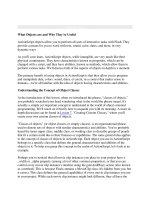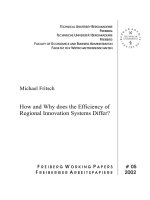Unconventional fracturing fluids what, where and why
Bạn đang xem bản rút gọn của tài liệu. Xem và tải ngay bản đầy đủ của tài liệu tại đây (1.16 MB, 45 trang )
Unconventional Fracturing Fluids : What,
Where and Why
D.V. Satya Gupta
Tomball Technology Center
© 2010 Baker Hughes Incorporated. All Rights Reserved.
A Wide Range of Fluid Systemsgy
• Water-Based Polymer Systems
Sf t tSt• Surfactant Systems
• Energised Systems
• Emulsion Systems• Emulsion Systems
• Non-aqueous Systems
– Oil-Based
– Methanol
© 2010 Baker Hughes Incorporated. All Rights Reserved.
g y
A
Wide Ran
g
e of Fluid S
y
stems
• Why So Many Fluids?
Diff t F ti
–
Diff
eren
t F
orma
ti
ons
• Base Lithology
• Additional Mineral Components
– Different Formation Fluids
– Different Objectives
Different P mping Config rations
–
Different P
u
mping Config
u
rations
–Etc.
© 2010 Baker Hughes Incorporated. All Rights Reserved.
Conventional Frac Fluids
• Water Based Polymer Systems
Wt ith F i ti R d
–
W
a
t
er w
ith F
r
i
c
ti
on
R
e
d
uce
r
– Base Gel
–
Crosslinked Water Based Fluid
• Borate Crosslinked
• Zirconium Crosslinked
High pH and Lo pH Fl ids
–
High pH and Lo
w
pH Fl
u
ids
– Low Polymer Systems
–
Ener
g
ized S
y
stems
g y
– Foams
© 2010 Baker Hughes Incorporated. All Rights Reserved.
y y
Wate
r
-Based Pol
y
mer S
y
stems
• Low Residue
• Base Fluid (Water) Is Inexpensive
• Continuous or Batch Mix
• Excellent Rheological Properties
© 2010 Baker Hughes Incorporated. All Rights Reserved.
y
Wh
y
Unconventional Fluids
• Tight Gas Wells
U ti l W ll
–
U
nconven
ti
ona
l W
e
ll
s
• Shales
• Coal Beds
• Wells with Adverse Capillary Effects
– Sub-irreducible Water Saturation
Sb
i d ibl H d b S t ti
–
S
u
b
-
i
rre
d
uc
ibl
e
H
y
d
rocar
b
on
S
a
t
ura
ti
on
© 2010 Baker Hughes Incorporated. All Rights Reserved.
ights Reserved. © 2010 Baker Hughes Incorporated. All R
Technical paperspapers
Water Sensitive Reservoirs
• Clay expansion - Smectite and mixed-layer clays are
water sensitive (swelling and fines migration)water-sensitive (swelling and fines migration).
• Clay dispersion - “water shock,” or “salinity shock.” : the
dispersion of poorly-cemented clays, such as some of thep p y y
more fragile versions of illitic clays or pore-filling kaolinite.
© 2010 Baker Hughes Incorporated. All Rights Reserved.
Undersaturated Gas Reservoirs
• Capillary undersaturation:
iiti l t t ti i l th ld b td d
–
i
n
iti
a
l
wa
t
er sa
t
ura
ti
on
i
s
l
ess
th
an wou
ld b
e expec
t
e
d
un
d
er
capillary equilibrium or irreducible water saturation
– also called sub-irreducible water saturation
© 2010 Baker Hughes Incorporated. All Rights Reserved.
g
Ti
g
ht Gas Reservoirs
• Aqueous Phase Trapping - Hydrocarbon permeability is
frequently reduced due to imbibition of aqueous treatment
frequently reduced due to imbibition of aqueous treatment
fluids during well operations. This imbibition effect has
been observed as a particularly severe problem in
reservoirs where a sub-irreducible water saturation exists.
© 2010 Baker Hughes Incorporated. All Rights Reserved.
q pp g
Aq
ueous Phase Tra
pp
in
g
• Understanding aqueous phase trapping is important due
to it being the driving force behind many low
permeability
to it being the driving force behind many low
-
permeability
stimulation decisions.
• Dia
g
nostic tools can be used in evaluatin
g
sensitivit
y
to
g g y
aqueous phase trapping.
© 2010 Baker Hughes Incorporated. All Rights Reserved.
Relative Permeability Decreases Due to Water
Imbibition
Imbibition
70
80
90
10 0
e
nt
K rw
K rg
40
50
60
70
Permeability, perc
e
R e la tiv e p e r m e a b ility
d ecreases r a p id ly as W a te r
S a tu ra tio n in creases .
10
20
30
40
Relative
0
0 2 0 4 0 6 0 8 0 1 0 0
W a te r S a tu ra tio n , P e rc e n t P o re S p a c e
W a te r
Im bibition
© 2010 Baker Hughes Incorporated. All Rights Reserved.
q
Remediation or Prevention Techni
q
ues
• Adding methanol to water-based treatments to reduce
water content lower interfacial tension and enhance the
water content
,
lower interfacial tension
,
and enhance the
evaporation of the water-based filtrate during reservoir
cleanup
• Use of non-aqueous fluids (methanol-based, oil-based, or
gas-based) to eliminate water injected into the formation
© 2010 Baker Hughes Incorporated. All Rights Reserved.
Unconventional Frac Fluids
• Polymer Systems
A M th l B d
–
A
queous
M
e
th
ano
l B
ase
d
– Non-Aqueous Methanol Based
•
Non Polymer Systems
Non Polymer Systems
– Surfactant Gels (VES)
– VES Foams
– Hydrocarbon Based
– Liquid CO
2
Based
© 2010 Baker Hughes Incorporated. All Rights Reserved.
q
Li
q
uid CO
2
Based Emulsion
2
• Minimize Water In Formation
25% ll d fl id
–
25%
ge
ll
e
d fl
u
id
• 40% Methanol
• Low Residue
• Rapid Clean Up
© 2010 Baker Hughes Incorporated. All Rights Reserved.
ess da a t a ea e s
y
Gelled Methanol S
y
stems
• 100% Gelled Methanol
–
Good for water
-
sensitive formations
Good for water
sensitive formations
• Low Surface Tension - Better Flowback
• Vapor Density
• New Gelling / Crosslinking Systems
– Easier to break
CO
tibl
–
CO
2
compa
tibl
e
– Wide temperature range
–
L
ess da
m
ag
in
g t
h
a
n
ea
rli
e
r
syste
m
s
g g syste
© 2010 Baker Hughes Incorporated. All Rights Reserved.
q
Crosslinked Non-
Aq
ueous Methanol
• Water Sensitive Formations
DG W ll
•
D
ry
G
as
W
e
ll
s
• Wells Damaged with Water
© 2010 Baker Hughes Incorporated. All Rights Reserved.
y
Surfactant S
y
stems
• Cationic + Salt
A h t i S lt
•
A
mp
h
o
t
er
i
c +
S
a
lt
• Cationic + Anionic
•
Anionic
•
Anionic
© 2010 Baker Hughes Incorporated. All Rights Reserved.
y
VES S
y
stem
• Two Surfactant System
Cti i Ai i
–
C
a
ti
on
i
c +
A
n
i
on
i
c
• Simple
–
Two fluids added on
-
the
-
fly
Two fluids added on
the
fly
• Formation Benign
– No residue, no formation damage
• Low Surface Tension
– No additional flow-back surfactant is needed
© 2010 Baker Hughes Incorporated. All Rights Reserved.
y
VES S
y
stem
• The System does not require
Bi id Cl C t l A t
–
Bi
oc
id
e or
Cl
ay
C
on
t
ro
l A
gen
t
– Buffer
•
Insensitive to salinity
Insensitive to salinity
• Flowback fluid can be reused
• Compatible with N
2
and CO
2
© 2010 Baker Hughes Incorporated. All Rights Reserved.
y
VES S
y
stem
• Shallow Gas Projects
• Tight Formations
• Maximize Fracture Conductivity
© 2010 Baker Hughes Incorporated. All Rights Reserved.
eserved.
ProppantProppant
ProppantProppant
PackPack
Clean up ofClean up of
Clean up ofClean up of
VES FluidVES Fluid
SystemSystem
Showin
g
NoShowin
g
No
DamageDamage
© 2010 Baker Hughes Incorporated. All Rights R
–
y
Foamed VES S
y
stem
• Two Surfactant System
NR id
•
N
o
R
es
id
ue
• Strong Self-Foaming Ability
–
No additional foamer needed
No additional foamer needed
• Cost Effective
• Foam Viscosit
y
: Same as Conventional Foams and also
y
adjustable
• High Quality Foams (>85 Quality) with Light Weight
Proppants
Proppants
© 2010 Baker Hughes Incorporated. All Rights Reserved.
Foamed VES Systemy
• Medium to High Temperature
Ud P dG Wll• Under Pressured Gas Wells
• High Permeability Wells
• Wells with Complex Fracture Issues• Wells with Complex Fracture Issues
• Coal Bed Methane Wells
• High Quality Foams for Shales gQ y
© 2010 Baker Hughes Incorporated. All Rights Reserved.
y
CO
2
S
y
stems
2
• Liquid CO
2
CO
/N
•
CO
2
/ N
2
• Unconventional CO
2
Foam
© 2010 Baker Hughes Incorporated. All Rights Reserved.









